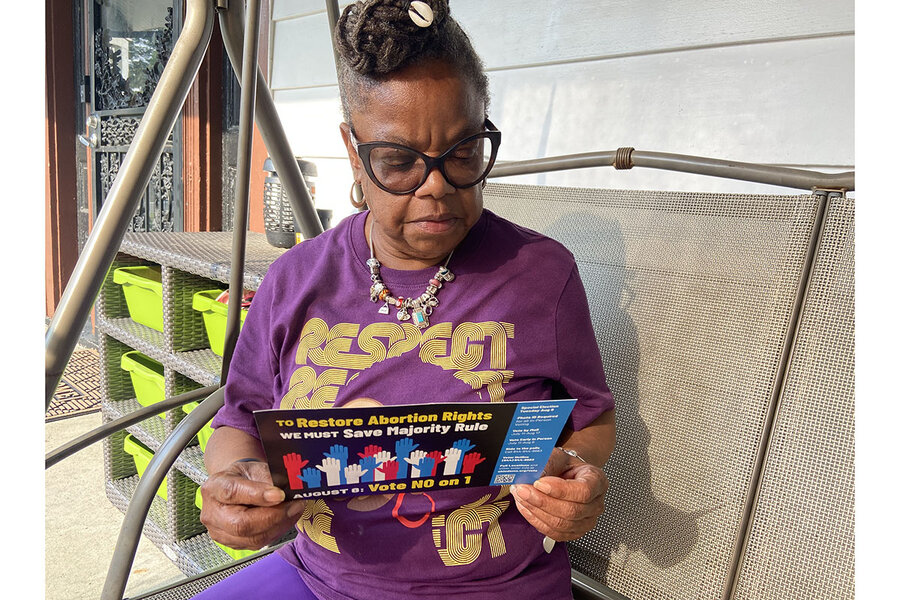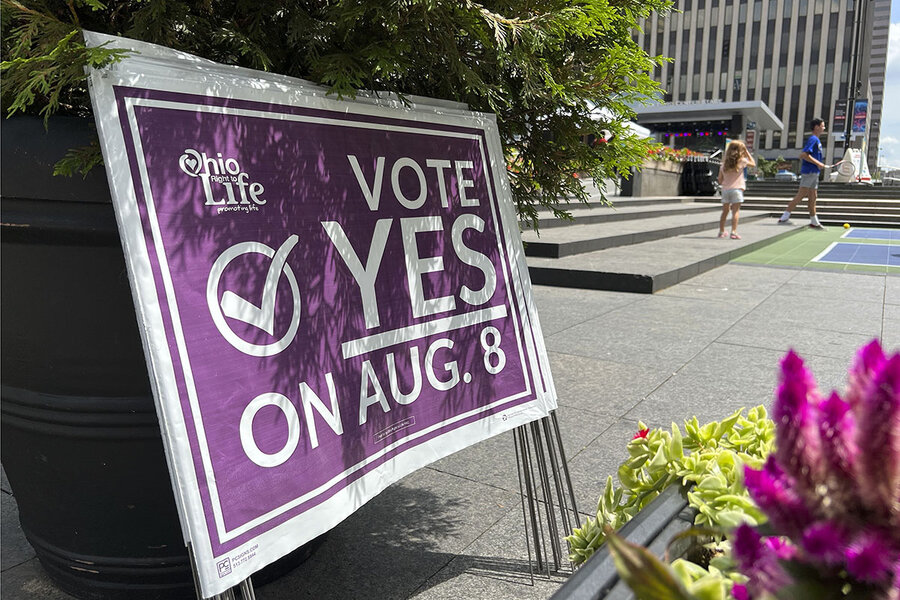In Ohio, abortion battle triggers fight over direct democracy
Loading...
| Cincinnati
Across Ohio, activists are urging voters to turn out in a special election next month to decide what The Columbus Dispatch calls “one of the most significant questions” in generations. The measure, called Issue 1, would make it harder for voters to amend the state constitution.
Behind this battle over direct democracy is one issue: abortion. Following the U.S. Supreme Court’s overturning of Roe v. Wade last year, abortion policy has become a state-by-state matter. And both sides are increasingly focusing on state constitutions. Last year, voters in Kentucky and Kansas rejected amendments to their constitutions that would have stated there was no right to an abortion. In Michigan and California, voters approved making abortion an explicit constitutional right.
Why We Wrote This
With abortion policy now up to states, activists are looking to state constitutions as a way to guarantee or deny rights. And that’s leading to battles over how easily constitutions can be amended.
Ohio is looming as the next high-profile test. An amendment on November’s ballot would guarantee a right to abortion in the state constitution. August’s special election is widely seen as an attempt to make it harder for that amendment to pass.
“This is primarily about abortion,” says former Gov. Ted Strickland, a Democrat. “They know if the people of Ohio have a chance to vote on this issue under current rules, it will pass – so they want to change the rules.”
Beverly Johnson votes without fail in every local, state, and federal election. But she didn’t know much about Ohio’s upcoming special election until last week, when singer-songwriter John Legend showed up at her house.
“I was on the porch when he came up,” says Ms. Johnson, a home day care provider. “I just [stood] there with my mouth open.”
Mr. Legend was in the majority-Black Cincinnati neighborhood encouraging residents to turn out and vote against the sole item on the Aug. 8 ballot – a Republican-written proposal known as Issue 1, which would make it harder to amend Ohio’s Constitution.
Why We Wrote This
With abortion policy now up to states, activists are looking to state constitutions as a way to guarantee or deny rights. And that’s leading to battles over how easily constitutions can be amended.
Across the state, activists have been deploying celebrities and urging voters to turn out for what The Columbus Dispatch calls “one of the most significant questions Ohio voters will be asked in generations.” If it passes, Issue 1 would raise the threshold for approving constitutional amendments to 60%, up from a simple majority. It also would make it harder for citizens to put such measures on the ballot in the first place.
Driving this battle over direct democracy is one issue in particular: abortion. Following the U.S. Supreme Court’s ending of 50 years of federal protection under Roe v. Wade, abortion policy has become a state-by-state matter. And supporters of abortion rights have been increasingly turning to language in state constitutions to try to preserve access, even in deep-red states.
Last year, voters in Kentucky and Kansas rejected proposed amendments to their constitutions that would have stated there was no right to an abortion, which in Kansas effectively upheld a court ruling blocking an abortion ban. In blue states like Michigan and California, voters approved making abortion an explicit constitutional right. This flurry of abortion-related ballot measures, which could be repeated next year, was also seen as helping to boost Democratic turnout in what had been forecast to be a punishing midterm cycle for President Joe Biden’s party.
Ohio is looming as the next high-profile test. A onetime swing state that now leans Republican, abortion is currently legal in Ohio up to 22 weeks of pregnancy. In 2019, Republican lawmakers passed a measure in anticipation of the end of Roe v. Wade that would ban abortion after six weeks, with limited exceptions. But after Roe was overturned, a state court put the measure on hold. The state Supreme Court is set to rule on an appeal.
Now Ohio voters are getting ready to decide on a November ballot measure that would explicitly guarantee a right to abortion in the state constitution. Republicans have made clear that August’s special election is an attempt to make it harder for that November amendment – which a recent poll found had 58% support – to pass.
“This is 100% about keeping a radical pro-abortion amendment out of our constitution,” Secretary of State Frank LaRose told a local GOP dinner in May, speaking about Issue 1. Mr. LaRose, who is Ohio’s top elections official, is seeking the Republican nomination to challenge Democratic Sen. Sherrod Brown in 2024.
Mike Gonidakis, the president of Ohio Right to Life and a prominent campaigner for Issue 1, says that while stopping abortions was his primary motivation, conservatives might have other reasons to want to curb citizen-initiated amendments. These include business owners worried about labor-backed minimum wage initiatives and gun owners wary of firearm-related amendments. “This is not just about abortion. ... There are a hundred reasons to vote yes [on Issue 1],” he says.
Mr. Gonidakis says that the state constitution shouldn’t be a policy document. “If the legislature wants to pass a law, they can do that. We can hold them accountable at the ballot box.”
Opponents of Issue 1 say the legislature has become less responsive to the will of the voters due to selectively drawn districts, where primaries often serve as the only competitive elections. If Issue 1 passes, they say, it would further entrench the power of Ohio’s GOP-run legislature and stifle popular reforms, including how those same lawmakers carve out their districts and those used for the U.S. Congress. Republicans last year overrode a ballot-initiated reform of redistricting, effectively converting the state’s Republican tilt into a legislative supermajority. Good-governance organizations say restrictions on constitutional amendments would stymie future efforts to tackle gerrymandering in Ohio.
A low-turnout election?
Both sides share one challenge: turning out voters in August. Only 8% cast a vote last August when parties held primaries for state legislative seats. Indeed, GOP lawmakers voted last year to scrap most special elections in August, calling them a waste of money. Mr. LaRose, the secretary of state, in 2021 described low-turnout elections as “bad news for the civic health of our state,” only to reverse that stance in support of Issue 1.
Apathy in summer elections is real, says Bob Clegg, a Republican consultant in Ohio. “Normal people don’t know about it. All they worry about is getting kids ready for school and finishing up vacation. They’re not focused on a special election,” he says.
Which is where celebrities like Mr. Legend come into the picture. As the Springfield native told a small crowd gathered outside a polling center last week, he had a day off from his taping schedule in Los Angeles for the upcoming season of “The Voice,” so what better way to spend it than canvassing for votes in Ohio, with TV crews in tow?
“I could have relaxed at home. But I couldn’t chill on this Tuesday afternoon. We’ve got important work we’ve got to do in Cincinnati,” he said.
In an interview after a lunch at a Baptist church, he described his role as raising public awareness of an election whose backers may have hoped it would go largely unnoticed. “I figure my job is to help bring attention to what’s happening,” he says. “Encourage people to vote, but also just make sure they know that this is happening.”
Ohio is one of 18 states that allow citizen-initiated constitutional amendments. Successful initiatives are relatively rare: Since 1913, only 71 such amendments have qualified for the Ohio ballot, according to the Dayton Daily News. Of these, 19 have been approved; 11 passed by margins of 60% or more. Ohio’s legislature can also put constitutional amendments on the ballot, as it did with Issue 1.
“I think most Ohioans are proud of the fact that we’re one of the states that have this initiative possibility,” says Ted Strickland, who served as Ohio’s governor from 2007 to 2011. “This has not been abused. It’s not resulted in our constitution being loaded with a lot of inappropriate policy matters.”
Mr. Strickland, a Democrat, is among four former Ohio governors – two Republicans, two Democrats – who have publicly opposed Issue 1, as have five former attorneys general from both parties. He calls it “an outrageous power grab” by lawmakers. “Anybody with their eyes open understands that this is primarily about abortion. They know if the people of Ohio have a chance to vote on this issue under current rules, it will pass – so they want to change the rules.”
Republicans have tried similar blocking tactics in other states that allow citizen-initiated constitutional amendments, so far to no avail. Voters in South Dakota and Arkansas rejected proposals last year to raise their thresholds for amendments to 60%. In Missouri, a proposal to raise it to 57% failed to pass in this year’s legislative session.
Early polls suggest that the Ohio effort may also fail. A poll conducted in July found that 57% of likely voters opposed Issue 1. Only 26% voiced support for the measure; the rest were undecided. Among Republicans, 4 in 10 said they were opposed.
Support for abortion access
Should Issue 1 fail, November’s constitutional amendment seems likely to succeed. A USA Today/Suffolk University poll this month found that 58% of Ohio voters favored creating a guaranteed right to abortion, including a third of Republicans and 85% of independent women. A Public Religion Research Institute poll in December found that 66% of Ohio residents wanted abortion to be legal in “most or all cases,” the same proportion as in neighboring Michigan, which had voted the previous month to enshrine a right to an abortion in its constitution.
But should Issue 1 pass, it would not only potentially impact November’s abortion measure, but also make it significantly harder to initiate future constitutional amendments. Groups currently need to gather signatures from 44 or more of Ohio’s 88 counties to qualify for the ballot. Issue 1 would require signatures from every county and eliminate a 10-day extension for finding additional signatures if any are ruled invalid.
What is already an arduous process would become almost impossible for groups without deep pockets, says Jonathan Entin, a professor emeritus of law at Case Western Reserve University. “It’s basically only special interests that will have a reasonable chance of getting an amendment on the ballot,” he says. “Your average neighborhood groups are going to have a lot harder time.”
And that could affect citizens on both sides of the ideological spectrum. For the past two years, Diana Smith, a certified nursing assistant, has been gathering signatures for a constitutional amendment in Ohio to limit vaccine mandates and outlaw discrimination against those who are unvaccinated. Her campaign is all volunteers, she says, and can’t afford to pay canvassers to collect signatures, so it’s been slow-going.
As a Republican, she’s unsure how to vote in next month’s special election, though she sees a higher threshold for constitutional amendments as fair. “I think 60% is OK, because if it’s a good initiative, it should be able to pass by 60%,” she says.
But the new rules on qualifying for the ballot strike her as undemocratic, which makes her a likely no vote on Aug. 8. “It’s already a hard process for Ohio citizens. I think it takes power away from ‘We the people.’”










